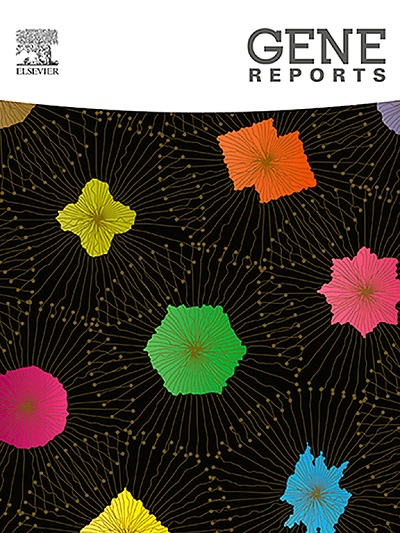使用 sgRNA 鸡尾酒,以 CRISPR/Cas 为介导,破坏 PK-15 细胞中的猪圆环病毒-1 基因
IF 0.9
Q4 GENETICS & HEREDITY
引用次数: 0
摘要
猪圆环病毒 1(PCV-1)是包括细胞系在内的所有猪源细胞的固有污染物。猪肾 15(PK-15)细胞就是这样一种细胞系,被广泛用于繁殖不同的猪病毒和开发猪用细胞培养疫苗。PCV1 是一种单链 DNA 病毒,在宿主细胞内呈环状,拷贝数较高。PK-15 细胞中 PCV1 病毒的存在可能会影响猪病毒和其他疫苗株(如经典猪瘟病毒(CSFV))的产量。因此,本研究旨在探索 CRISPR/Cas9 工具在切割 PK-15 细胞中的 PCV-1 DNA 方面的前景,然后评估这些细胞在生产 CSF 疫苗病毒方面的产量。PK-15 细胞在 CRISPR/Cas9 的介导下,使用鸡尾酒引导 RNA(sgRNA)裂解 PCV-1 DNA。在液滴数字 PCR 和实时 PCR 中观察到转染细胞中 PCV-1 DNA 明显减少,这表明所选 sgRNA 成功靶向了 PCV-1 DNA。此外,用 CSFV 感染 PCV-1 被裂解的 PK-15 细胞,发现收获的病毒产量更高。根据本研究,可以认为从 PK-15 细胞中敲除 PCV-1 DNA 为生成无污染细胞系和开发产量更高的疫苗提供了一个前景广阔的平台。本文章由计算机程序翻译,如有差异,请以英文原文为准。
CRISPR/Cas mediated disruption of the Porcine Circovirus-1 gene present in PK-15 cells using sgRNA cocktail
Porcine circovirus 1(PCV-1) is an inherent contaminant in all cells of porcine origin, including cell lines. Porcine Kidney 15 (PK-15) cells are one such cell line which are widely being used for the propagation of different porcine viruses and development of cell culture vaccines for pigs. PCV1 is a single-stranded DNA virus that remain in circular form with a high copy number inside the host cell. The presence of PCV1virus in PK-15 cells may affect the yield of porcine viruses and other vaccine strains like Classical Swine Fever Virus (CSFV) propagated in these cells. Hence the present study was conducted to explore the promising CRISPR/Cas9 tool in cleaving PCV-1 DNA from PK-15 cells, followed by the evaluation of these cells for producing CSF vaccine virus with better yield. PK-15 cells were subjected to CRISPR/Cas9 mediated cleavage with a cocktail of guide RNAs (sgRNAs) to cleave PCV-1 DNA. A significant reduction of PCV-1 DNA in the transfected cells was observed in droplet digital PCR and real-time PCR; indicating successful targeting of PCV-1 DNA by the chosen sgRNAs. Further, the PCV-1 cleaved PK-15 cells were infected with CSFV and found to have a better yield of harvested virus. Based on the present study, it can be suggested that knocking out of PCV-1 DNA from PK-15 cells offers a promising platform for generating contaminant free cell lines and vaccine development with higher yield.
求助全文
通过发布文献求助,成功后即可免费获取论文全文。
去求助
来源期刊

Gene Reports
Biochemistry, Genetics and Molecular Biology-Genetics
CiteScore
3.30
自引率
7.70%
发文量
246
审稿时长
49 days
期刊介绍:
Gene Reports publishes papers that focus on the regulation, expression, function and evolution of genes in all biological contexts, including all prokaryotic and eukaryotic organisms, as well as viruses. Gene Reports strives to be a very diverse journal and topics in all fields will be considered for publication. Although not limited to the following, some general topics include: DNA Organization, Replication & Evolution -Focus on genomic DNA (chromosomal organization, comparative genomics, DNA replication, DNA repair, mobile DNA, mitochondrial DNA, chloroplast DNA). Expression & Function - Focus on functional RNAs (microRNAs, tRNAs, rRNAs, mRNA splicing, alternative polyadenylation) Regulation - Focus on processes that mediate gene-read out (epigenetics, chromatin, histone code, transcription, translation, protein degradation). Cell Signaling - Focus on mechanisms that control information flow into the nucleus to control gene expression (kinase and phosphatase pathways controlled by extra-cellular ligands, Wnt, Notch, TGFbeta/BMPs, FGFs, IGFs etc.) Profiling of gene expression and genetic variation - Focus on high throughput approaches (e.g., DeepSeq, ChIP-Seq, Affymetrix microarrays, proteomics) that define gene regulatory circuitry, molecular pathways and protein/protein networks. Genetics - Focus on development in model organisms (e.g., mouse, frog, fruit fly, worm), human genetic variation, population genetics, as well as agricultural and veterinary genetics. Molecular Pathology & Regenerative Medicine - Focus on the deregulation of molecular processes in human diseases and mechanisms supporting regeneration of tissues through pluripotent or multipotent stem cells.
 求助内容:
求助内容: 应助结果提醒方式:
应助结果提醒方式:


